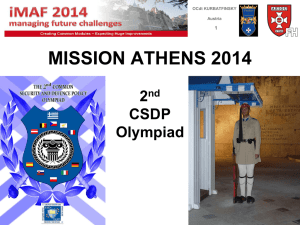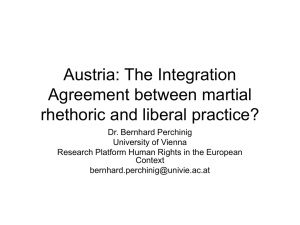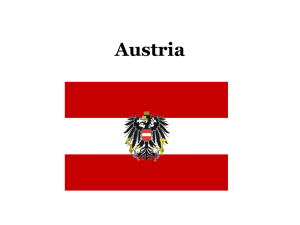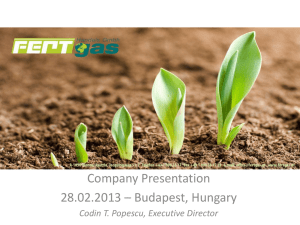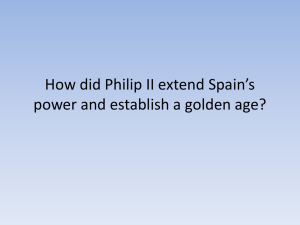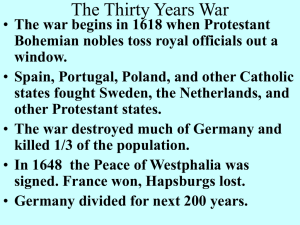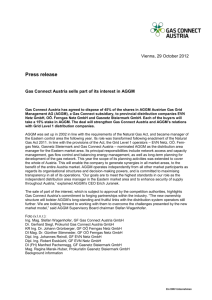Austria`s Water Management
advertisement
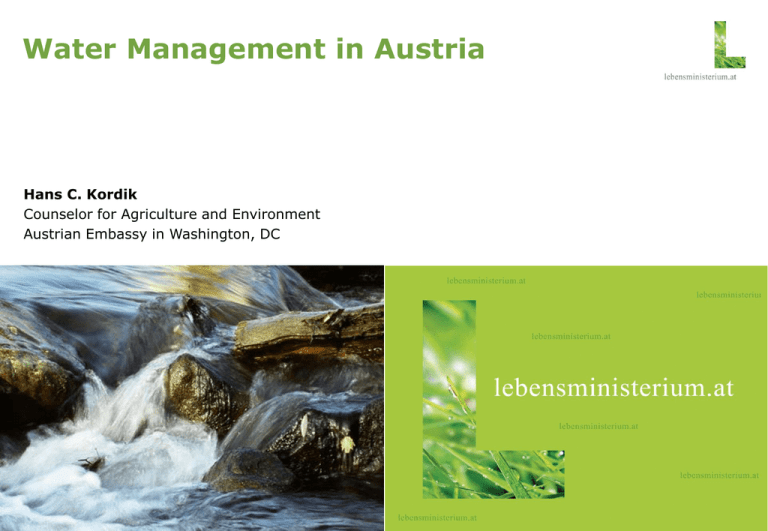
Water Management in Austria Hans C. Kordik Counselor for Agriculture and Environment Austrian Embassy in Washington, DC Austria – Basic Facts & Figures Member State of the European Union since 1995 Size: 32,000 m2 (which is two and half times the size of Minnesota) Population: 8.4 million GDP per capita: $48,000 (10th wealthiest country of the world) Mountainous regions: 67% of country Forest cover: 48% of country Facts on Austrian Jurisdiction Federal state with 9 provinces Competences are shared Topographic Challenges 1. Austria is a mountainous country. Only 32% below 500 meters. 2. High precipitation and high slopes entail considerable natural hazards Challenge Agriculture Challenges due to Precipitation Precipitation mm/a < 500 - 600 - 700 - 850 - 1000 - 1250 - 1500 - 1750 - 2000 - 2500 -3500 Challenges due to Population Density 1) Population density in alpine valleys is similar to density in big cities! 2) Consequences: areas extremely vulnerable to natural hazards, impacts on river morphology, river continuity, loss of wetlands due to flood protection… Diversity of Water Uses – Challenges and Impacts Tourism Nature Protection Agriculture Flood Protection Waste Water Drinking Water Industry Navigation & Hydropower Three Pillars of Austrian Water Policy 1. Protection against natural hazards • Investments of around €340 million in the last years; • Flood risk management is priority until 2015 (EU-legislation) 2. Protection of waters against pollution • all waste waters from settlements and industrial sites are treated with best available techniques, • so far investments of more than €41 billion have been made 3. Preservation and restoration of good ecological status (e.g. river continuity, residual water…) In Austria less than 4% of the water resources are used! Water Quantity & Quality is Austria‘s Asset Unterschiede in der Ausgangsposition - Nutzung Countries ask for legislative solutions at EU level Austria < 4% water uses Source: EEA, WEI International Cooperation 1) Austria shares 3 int. River Basins 2) EU legislation (WFD) obliges MS to set up shared management plan Elbe River 3) Austria cooperates • • with riparian countries via the Int. River Commissions With neighbors via transboundary water commissions River Basin Basin area Austrian share [km²] Austrian share [%] Countries Danube 801.463 80.574 10.0 % 19 Rhine 197.080 2.365 1,3 % 9 Elbe 148.269 921 0,6 % 4 Rhine Vienna Danube River International Cooperation with Neighbors • Austria has with almost all the neighbors treaties (except Italy) • Treaties date back to the time of the “Iron Curtain” - a time when the borders were impassable because of barbed wire and mines • Treaties remained in force, even after the collapse of the communist countries (Yugoslavia, Czechoslovakia) • No common "secretariats", but the water administrations of the countries negotiate at high level with the respective State, by their respective mandate, no involvement of the diplomatic service • Over the decades most issued could be solved on expert level; in one case, the government and presidents of both countries were involved • Common water legislations in the European Union help cooperation • Water scarcity / water quantity is slowly getting a topic of interest, of course also Climate Change Water – Key Asset of Austria • Austria – abundant water resources, in best quality; < 4% used; => key asset in particular for future • • Austria in favorable position surrounded by countries in east and south, where Climate Change will bring increasingly water scarcity + droughts => AT insists on unanimity in all issues concerning quantative management of waters within EU legislation => AT hesitant to ratify UN Water Convention for formal reasons, however in practice rather flexible to meet requests Main Restoration Measures needed in Austria Restoring river continuity Increasing habitats diversity in regulated or dammed rivers Restorating of ecological minimum flows Minimising flow variations/ water level fluctuations Hydropower is largely affected Electricity Generation in Austria More than 60% is generated by hydropower (hp) In the last years the proportion of hp generation decreased due to higher consumption higher use of other renewables generation Electricity production in Austria 2004 total electricity generation: 64 TWh RES-Directive: Increase from 31% to 34% in 2020 others* 39,0% large hp 54,5% large hp small hp hydropower generation 6,5% small hp 75% of hydropower potential is already exploited others source: E-control *biomass, wind, solar, etc. Share of Renewable Energy in Austria Sustainable Waste management strategy Precautionary Principle and Sustainability Objectives: Minimizing harmful, detrimental or other effects hazardous to human being, the environment or basics of life Minimizing of emissions of our pollution and GHG Conservation of raw material and energy ressources Lowest possible exploitation of landfill volume Recycling material with the same quality as primary resources Federal Waste Management Act 2002 Waste [Management] Hierarchy Order of priorities PREVENTION REUSE OF WASTE Best environmental outcome RECYCLING (COMPOSTING) OTHER RECOVERY Moving waste management up the hierarchy DISPOSAL Life-cycle thinking Waste Management in Austria Vienna’s Wastewater Treatment Plant Best Practice Example of Austrian Technologies Does not only purify the waste-water of Vienna households…. …. it uses several renewable energy technologies to minimize the required resource input • Combination of solar thermal, photovoltaic, and wind produces necessary electricity • An integrated CHP uses the energy of the sewage gas to produce electricity and heat By 2020, this plant will be 100% energy self-sufficient Implementation Nitrates directive in Austria • Codes of good agricultural practice – 1995 (year of accession to EU) • Decision to apply the action program throughout the national territory - 1996 • Action Programs 1996, 1999, 2003, 2008 • Derogation according to Annex III - 2006 Action Program – Periods in which Fertilizer Application is Forbidden Period 15 October 15 February 15 November 15 February 30 November 15 February Fertilizer Mineral fertilizer, slurry, sewage sludge Solid manure, compost Areas Agricultural area without green cover Agricultural area with green cover Agricultural area For cultures cultivated early in the year (e.g. spring barley, vegetables) and green covers with early nitrogen demand (e.g. rapeseed, winter barley) application is allowed from 1 February . Application is not allowed on frozen soils, snow covered soils and water saturated soils Control System • National Water Quality Monitoring system: ~ 2.000 groundwater monitoring sites ~ 250 surface water monitoring sites • Controls by water inspectorate: check of sites, installation and water quality • Controls by Farm Service Agency: ÖPUL (11,500 farms in 2004; ~ 7 %) cross compliance mainly on-site controls • Information / Advisory services are very important Austrian Water Technologies are Going International Product Portfolio includes: • Construction, operation, and maintenance of water and wastewater infrastructure • System design of waste water disposal and sludge treatment • Process water systems (e.g. cooling/heating systems, desalination, decalcification) • Hydropower plants • Construction of rainwater collectors • Irrigation equipment in agriculture • Seawater desalination Austrian water technologies can be found on all continents Thank you for your attention!


